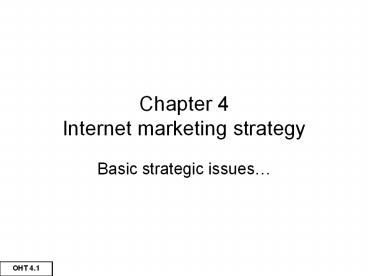Chapter 4 Internet marketing strategy PowerPoint PPT Presentation
1 / 23
Title: Chapter 4 Internet marketing strategy
1
Chapter 4Internet marketing strategy
- Basic strategic issues
2
Learning objectives
- Relate Internet marketing strategy to marketing
and business strategy - identify opportunities and threats arising from
the Internet - evaluate alternative strategic approaches to the
Internet.
3
Questions for marketers
- How does Internet marketing strategy relate to
other strategy development? - What are the key strategic options for Internet
marketing?
4
Michael Porter on the Internet
- The key question is not whether to deploy
Internet technology companies have no choice if
they want to stay competitive but how to deploy
it.
Porter, M. (2001) Strategy and the Internet,
Harvard Business Review, March 2001, 6278.
5
Influences on e-marketing strategy
Figure 4.1 Internal and external in?uences on
Internet marketing strategy
6
Stages in Internet development
Figure 4.2 A simple framework for Internet
marketing strategy development
7
Strategy development process
Figure 4.3 A ten-step strategic marketing
planning process Source McDonald, 1999
8
Dynamic strategy model
Figure 4.4 Dynamic e-business strategy
model Source Adapted from description in
Kalakota and Robinson (2000)
9
Stage models (Quelch and Klein (1996))
Figure 4.5 Levels of web site development in (a)
the information to transaction model and (b) the
transaction to information model of Quelch and
Klein (1996)
10
E-business strategy model
11
Types of web presence
- 1. Transactional e-commerce site.
- 2. Services-oriented relationship building web
site. - 3. Brand-building site.
- 4. Portal site.
12
Demand analysis car market
Figure 4.6 Customer demand analysis for the car
market
13
Demand analysis new vs existing
Figure 4.7 Demand analysis assessing the ratios
Access Choose Buy for (a) new customers and
(b) existing customers
14
Internet SWOT
Figure 4.8 A generic SWOT analysis showing
typical opportunities and threats presented by
the Internet
15
Internet marketing benefits
- Intangible benefits
- Corporate image communication
- Enhance brand
- More rapid, more responsive marketing
communications including PR - Improved customer service
- Learning for the future
- Meeting customer expectations
- Identify new partners, support existing partners
- Better management of marketing information and
customer information - Feedback from customers on products
- Tangible benefits
- Increased sales from new sales leads giving rise
to increased revenue from - new customers, new markets
- existing customers (repeat-selling)
- existing customers (cross-selling)
- Cost reductions from
- reduced time in customer service
- online sales
- reduced printing and distribution costs of
marcomms
16
Example objectives
- Achieve 10 per cent online revenue contribution
within two years - achieve first or second position in category
penetration in the countries within which we
operate (this is effectively online market share
and can be measured through visitor rankings such
as Hitwise (Chapter 2) or better by online
revenue share - cost reduction of 10 per cent in marketing
communications within two years - increase retention of customers by 10 per cent
- increase by 20 per cent within one year the
number of sales arising from a certain target
market, e.g. 1825-year-olds - create value-added customer services not
available currently - improve customer service by providing a response
to a query within two hours, 24 hours per day,
seven days a week - all other objectives to be achieved profitably
giving a return on investment in a three year
period.
17
Online revenue contribution examples
Table 4.3 Variations in online revenue
contribution
18
Product suitability to e-commerce
Figure 4.9 Grid of product suitability against
market adoption for transactional e-commerce
(online purchases)
19
Target marketing
Figure 4.10 Stages in target marketing strategy
development
20
Common online targeting options
- Brand loyalists convert online
- Not brand loyal encourage trial
- Most profitable deepen relationships
- Larger companies (B2B)
- Smaller companies(B2B)
- Key members of the buying unit (B2B)
- Difficult to reach using other media
21
The value proposition
- First identify customer needs and define a
distinctive value proposition that will meet
them, at a profit. The value proposition must
then be delivered through the right product and
service and the right channels and it must be
communicated consistently. The ultimate aim is to
build a strong, long-lasting brand that delivers
value to the company marketing it.
Varianini and Vaturi (2000)
22
Strategy options
Figure 4.14 Strategic options for a company in
relation to the importance of the Internet as a
channel
23
Risk/reward analysis
Figure 4.16 Example of riskreward analysis

